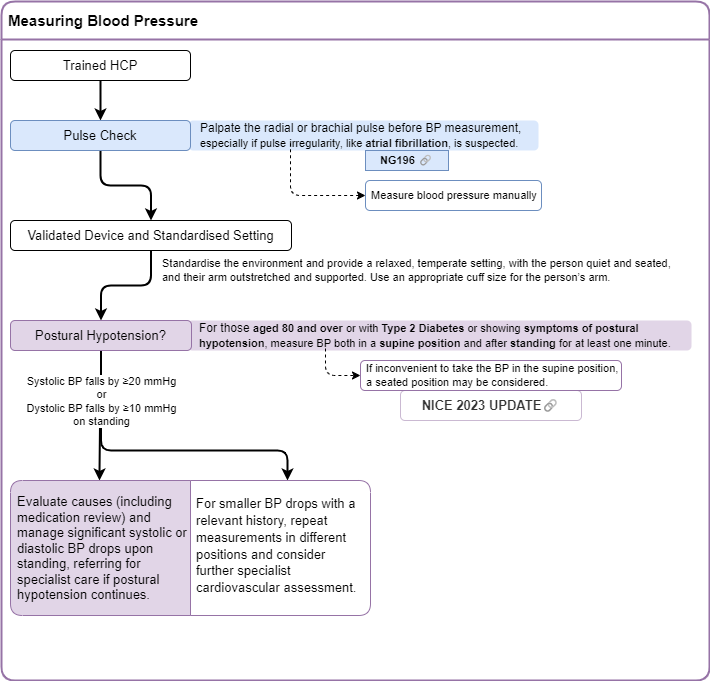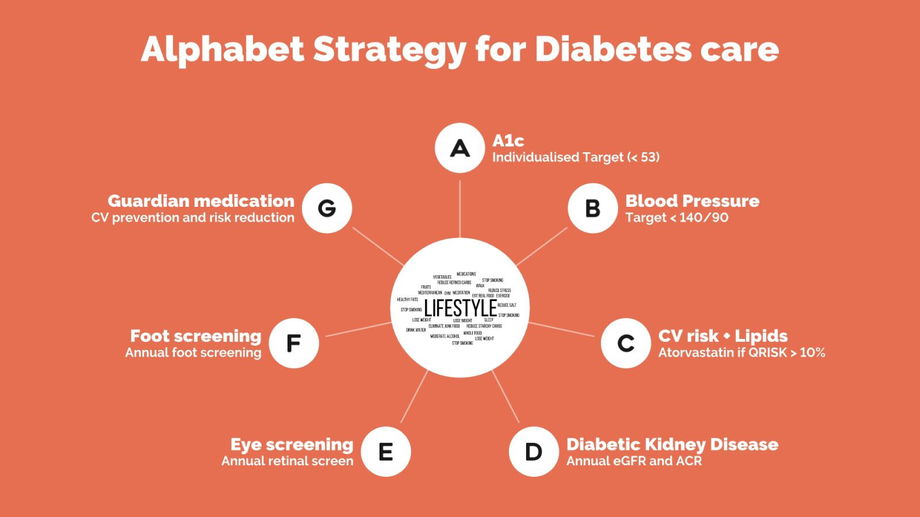Definition and Classification of Hypertension
-
- Clinic blood pressure (BP) between 140/90 mmHg and 159/99 mmHg.
- Average daytime ambulatory BP monitoring (ABPM) or home BP monitoring (HBPM) between 135/85 mmHg and 149/94 mmHg.[NG136; CKS; PatientPro]
-
Stage 2 Hypertension
- Clinic BP of 160/100 mmHg or higher but less than 180/120 mmHg.
- Subsequent ABPM daytime average or HBPM average BP of 150/95 mmHg or higher.[NG136; CKS; PatientPro]
-
Stage 3 or Severe Hypertension
- Clinic systolic BP of 180 mmHg or higher, or clinic diastolic BP of 120 mmHg or higher.[NG136; CKS; PatientPro]
-
Accelerated (Malignant) Hypertension
- Severe increase in BP to 180/120 mmHg or higher (often over 220/120 mmHg).
- Signs of retinal hemorrhage and/or papilloedema (swelling of the optic nerve).
- Usually associated with new or progressive target organ damage.[NG136; CKS]
-
Target Organ Damage
- Damage to organs such as the heart, brain, kidneys, and eyes.
- Examples include left ventricular hypertrophy, chronic kidney disease, hypertensive retinopathy, or increased urine albumin:creatinine ratio.[NG136]
-
Established Cardiovascular Disease
- History of ischemic heart disease, cerebrovascular disease, peripheral vascular disease, aortic aneurysm, or heart failure.
- Generally associated with a build-up of fatty deposits inside the arteries (atherosclerosis) and an increased risk of blood clots.[NG136]
-
Masked Hypertension
- Normal clinic BP measurements (less than 140/90 mmHg).
- Higher BP measurements outside the clinic using average daytime ABPM or average HBPM.[NG136; CKS]
-
White-Coat Effect
- A discrepancy of more than 20/10 mmHg between clinic and average daytime ABPM or average HBPM BP measurements at the time of diagnosis.[NG136; CKS]
-
Additional Perspectives and Classification Criteria
International Guidelines
- American College of Cardiology (ACC)/American Heart Association (AHA) defines hypertension as systolic BP ≥130 mmHg or diastolic BP ≥80 mmHg.[BMJ]
- European Society of Cardiology (ESC) and European Society of Hypertension (ESH) define hypertension as office systolic BP ≥140 mmHg and/or diastolic BP ≥90 mmHg.[BMJ]
- World Health Organization (WHO) recommends starting pharmacological treatment for confirmed hypertension with systolic BP ≥140 mmHg or diastolic BP ≥90 mmHg.[BMJ]
-
Primary and Secondary Hypertension
- Primary hypertension occurs in about 90% of people with no identifiable cause.
- Secondary hypertension occurs in about 10% of people with a known underlying cause, such as renal, endocrine, or vascular disorder, or the use of certain drugs.[CKS]
Measuring Blood Pressure
-
Training and Device Maintenance
- Initial Training and Periodic Review: Ensure healthcare professionals taking blood pressure measurements have adequate initial training and periodic review of their performance. [NG136]
- Device Validation and Maintenance: Healthcare providers must ensure that devices for measuring blood pressure are properly validated, maintained, and regularly recalibrated according to manufacturers' instructions. [NG136]
-
Measurement Technique
- Pulse Check for Irregularity: Before measuring blood pressure, palpate the radial or brachial pulse. If pulse irregularity (e.g., due to atrial fibrillation) is present, measure blood pressure manually using direct auscultation over the brachial artery. [NG136, CKS]
- Environment Standardization: When measuring blood pressure in the clinic or at home, provide a relaxed, temperate setting with the person quiet, seated, and their arm outstretched and supported. [NG136, CKS]
- Cuff Size and Position: Use an appropriate cuff size for the person's arm. The bladder should encircle at least 80% of the arm. [NG136, BMJ]
- Arm Selection for Measurement: Measure blood pressure in both arms using an appropriate cuff size. If there's a difference of more than 15 mmHg between arms, repeat the measurements and use the arm with the higher reading for subsequent measurements. [CKS, BMJ]
-
Special Considerations
- Postural Hypotension: For individuals with symptoms of postural hypotension (falls or postural dizziness), measure blood pressure with the person either supine or seated and then again with the person standing for at least 1 minute before measurement. [NG136, CKS]
- Systolic Blood Pressure Drop: If the systolic blood pressure falls by 20 mmHg or more when the person is standing, review medication, measure subsequent blood pressures with the person standing, and consider referral to specialist care if symptoms persist. [NG136, CKS]
- Multiple Measurements: If blood pressure measured in the clinic is 140/90 mmHg or higher, take a second measurement. If the second measurement differs significantly, take a third measurement and record the lower of the last two as the clinic blood pressure. [CKS, BMJ]
-
Pre-Measurement Preparation
- Preparation Prior to Measurement: The patient should avoid caffeine, smoking, and exercise for 30 minutes prior to examination. During the measurement, the patient should be seated quietly for at least 5 minutes with feet on the floor and arm supported at heart level. [BMJ]
-
Conflict Resolution
- Measurement in Both Arms: NG136 does not explicitly mention measuring in both arms, whereas CKS and BMJ emphasize its importance.
- Number of Measurements: NG136 lacks specific guidance on the number of measurements to take if the first is high, which CKS and BMJ provide.
Diagnosing Hypertension
If clinical BP < 140/90
- Measure blood pressure in both arms for hypertension diagnosis.
- Repeat measurements if the difference between arms is over 15 mmHg.
- If the difference remains over 15 mmHg, use the arm with the higher reading for future measurements.
- No CKD or Type 2 Diabetes
- If clinic blood pressure is < 140/90 mmHg
- Check BP at least every 5 years and more often if close to 140/90 mmHg
- Type 2 Diabetes
- Measure blood pressure at least annually
- Provide and emphasise preventive lifestyle advice.
- CKD
- Manage as per the NICE CKD guideline [NG203]
If clinic BP 140/90 - 179/119
Measuring blood pressure
- Measure blood pressure in both arms for hypertension diagnosis.
- Repeat measurements if the difference between arms is over 15 mmHg.
- If the difference remains over 15 mmHg, use the arm with the higher reading for future measurements.
- If clinic blood pressure is 140/90 mmHg or higher, take a second measurement.
- If the first and second measurements differ significantly, take a third measurement.
- Record the lower of the last two measurements as the clinic blood pressure.
- Offer ABPM
- While waiting for confirmation of a diagnosis of hypertension, carry out:
- investigations for target organ damage, followed by
- formal assessment of cardiovascular risk [QRISK]
- CONFIRM DIAGNOSIS
- If the clinic BP ≥ 140/90 mmHg and daytime ABPM (or HBPM) average ≥ 135/85 mmHg
- Stage 1 hypertension:
- Clinic BP - 140/90 mmHg to 159/99 mmHg.
- ABPM/HBPM - 135/85 mmHg to 149/94 mmHg.
- Stage 2 hypertension:
- Clinic BP - 160/100 mmHg to 179/119 mmHg.
- ABPM/HBPM ≥ 150/95 mmHg.
- Stage 3 or severe hypertension:
- Clinic BP ≥ 180/120
- Accelerated (Malignant) hypertension:
- Clinic BP ≥ 180/120 with retinal haemorrhage and/or papilloedema
- Stage 1 hypertension:
- If the clinic BP ≥ 140/90 mmHg and daytime ABPM (or HBPM) average ≥ 135/85 mmHg
- If hypertension is not diagnosed but there is evidence of target organ damage, consider carrying out investigations for alternative causes
- If hypertension is not diagnosed, measure the person's clinic blood pressure at least every 5 years subsequently, and consider measuring it more frequently if the person's clinic blood pressure is close to 140/90 mmHg.
If clinic BP ≥ 180/120
Measuring blood pressure
- Measure blood pressure in both arms for hypertension diagnosis.
- Repeat measurements if the difference between arms is over 15 mmHg.
- If the difference remains over 15 mmHg, use the arm with the higher reading for future measurements.
- If clinic blood pressure is 140/90 mmHg or higher, take a second measurement.
- If the first and second measurements differ significantly, take a third measurement.
- Record the lower of the last two measurements as the clinic blood pressure.
- CONSIDER THE NEED FOR SAME-DAY REFERRAL
- Accelerated hypertension
- BP ≥ 180/120 mmHg (often over 220/120 mmHg) with signs of retinal haemorrhage and/or papilloedema (swelling of the optic nerve). It is usually associated with new or progressive target organ damage and is also known as malignant hypertension.
- Life-threatening symptoms
- such as new onset confusion, chest pain, signs of heart failure, or acute kidney injury
- Suspected phaeochromocytoma
- labile or postural hypotension, headache, palpitations, pallor, abdominal pain or diaphoresis
- Stage 3 or severe hypertension:
- Clinic BP ≥ 180/120
- Accelerated (Malignant) hypertension:
- Clinic BP ≥ 180/120 with retinal haemorrhage and/or papilloedema


